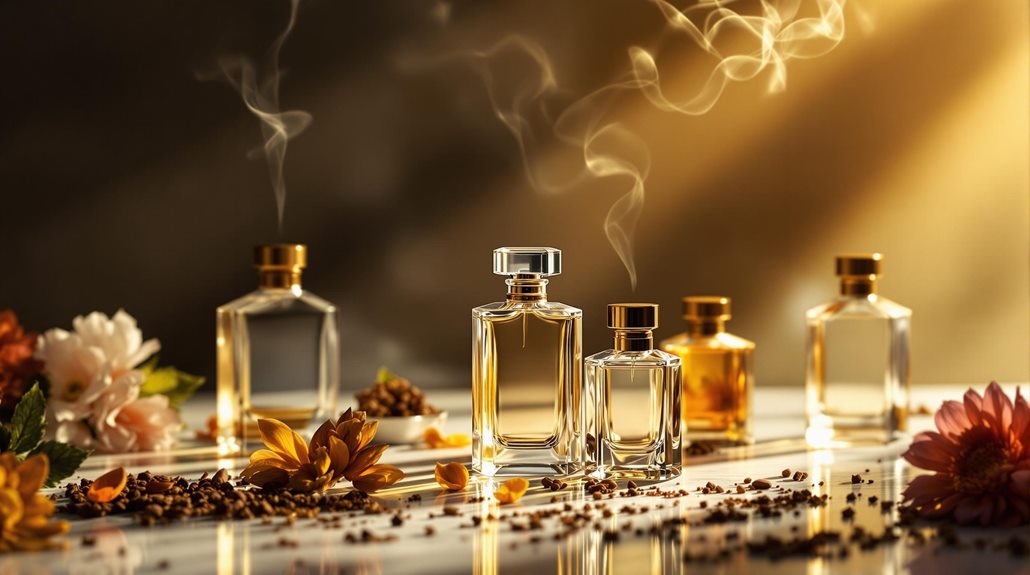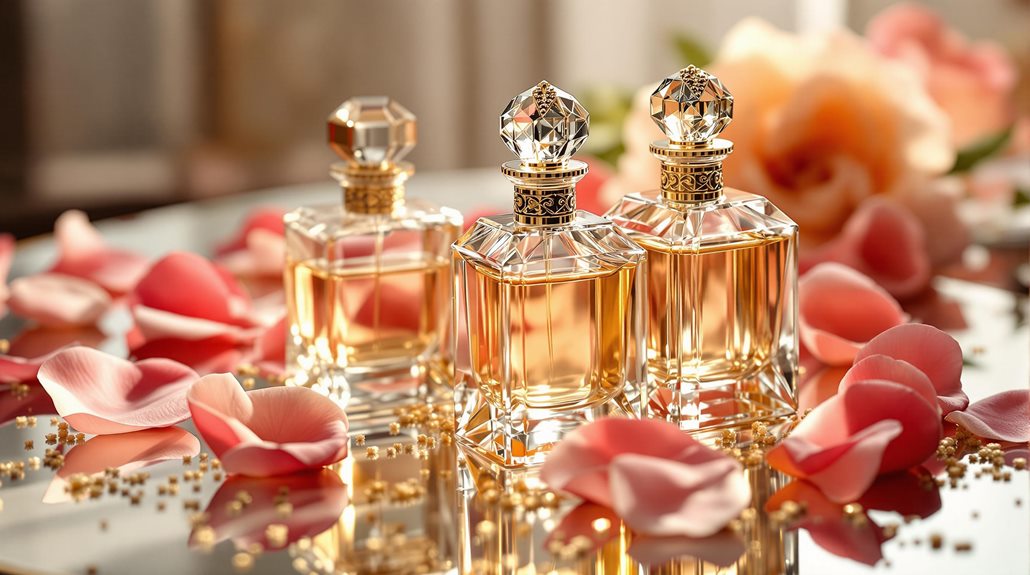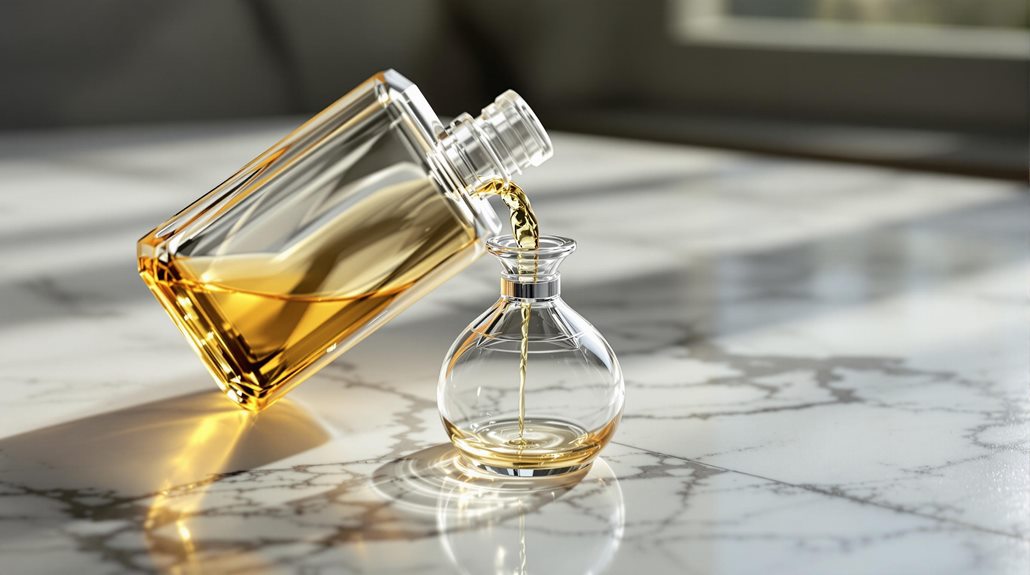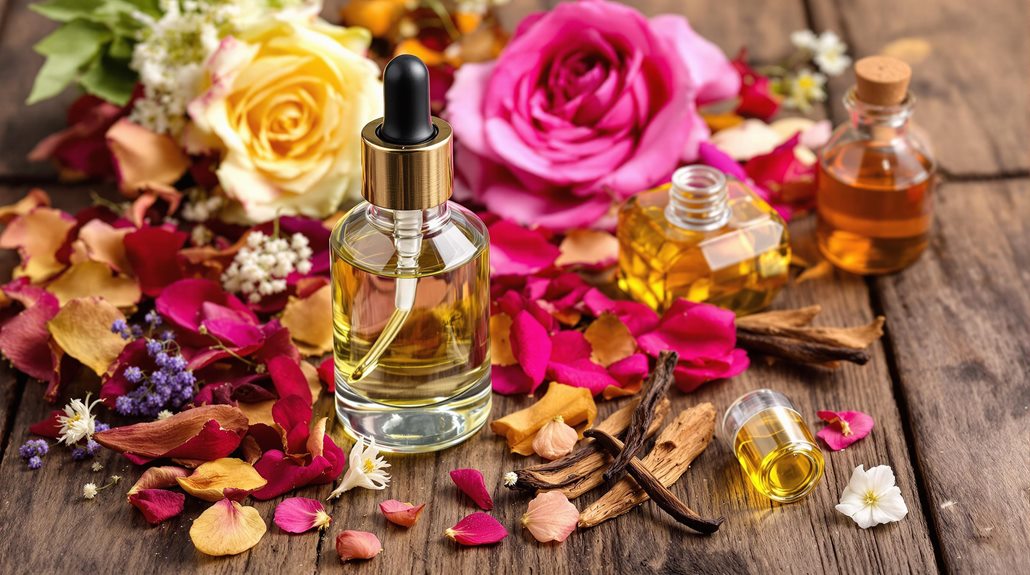Who Invented Perfume? A Journey Through the History of Fragrance
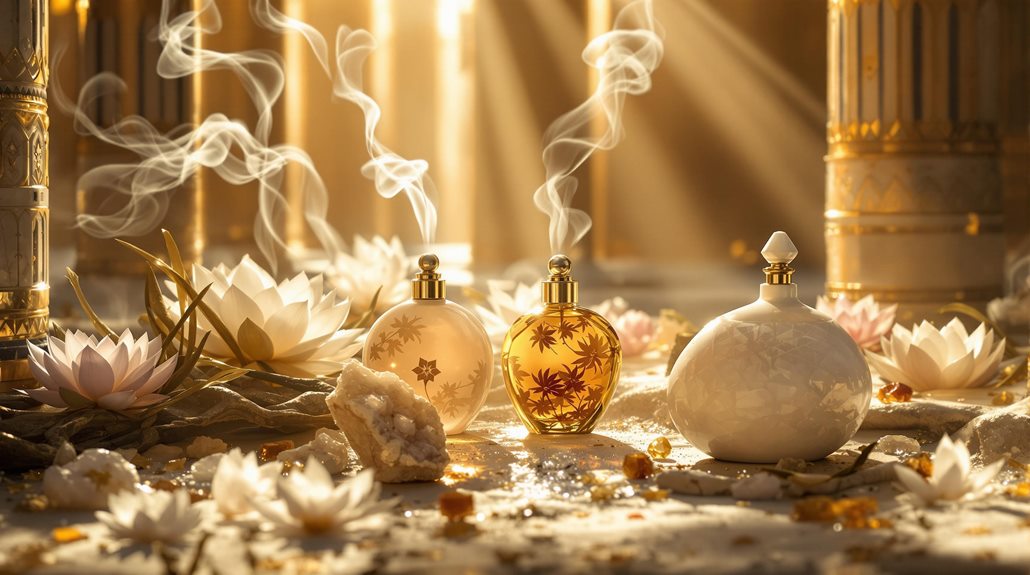
The earliest perfume origins stretch back over 4,000 years to ancient Mesopotamia, where you'll find Tapputi-Belatekallim, the world's first documented perfume maker. She pioneered sophisticated distillation techniques around 1200 BC, revolutionizing how fragrances were created. As trade routes expanded, perfumery evolved through Egyptian sacred rituals, Greek mythology, Roman luxury, and Islamic Golden Age innovations. You'll uncover that perfume wasn't invented by a single person but emerged through a rich tapestry of cultural contributions, from ancient priests to Renaissance experts. The fascinating expedition through fragrance history reveals countless pioneers who shaped the art we comprehend today.
Ancient Mesopotamian Fragrance Origins
Deep in the cradles of civilization, perfume emerged over 4,000 years ago in ancient Mesopotamia, where people uncovered the alluring properties of aromatic resins and herbs. You'll find that these early fragrance pioneers didn't just burn incense for pleasure; they incorporated it into religious ceremonies and used it as a marker of social status within their communities.
The ancient Mesopotamian chemist Tapputi-Belatekallim stands out as a crucial figure in perfume's history. As the world's first documented perfume-maker, she revolutionized the art of fragrance around 1200 BC by developing sophisticated distillation techniques for flowers, oils, and calamus. You can trace many modern perfumery methods back to her pioneering work.
The impact of these aromatic innovations extended far beyond personal use. You'll see how the trade of exotic ingredients transformed Mesopotamian society, creating lucrative economic networks and cultural exchanges. The careful selection of resins and herbs reflected not only their technical knowledge but also their deep connection to the environment. This foundation of ancient fragrance creation would later influence Egyptian practices, including the development of complex incense formulations like Kyphi.
Egyptian Sacred Scents
Ancient Egyptian perfumery enhanced fragrance from mere adornment to divine connection, with countless sacred scents playing crucial roles in religious ceremonies and burial practices. You'll find evidence of this in the discovery of ancient perfume vessels dating back over three millennia, showcasing the Egyptians' masterful understanding of aromatic plants and materials.
In religious rituals, you'd witness priests burning aromatic substances like Kyphi, a sacred incense crafted from 16 distinct ingredients, to honor their deities. During ceremonies, both priests and nobility would wear balsamic-scented cones atop their heads, releasing fragrant oils as they melted. These scented oils weren't just for the living - they played a vital role in ancient Egyptian burial customs.
The mummification process relied heavily on aromatic materials, with specific perfumes and resins carefully wrapped within the deceased's bandages. Ancient Egyptian texts reveal sophisticated perfume recipes combining floral, woody, and spice elements, demonstrating their advanced knowledge of fragrance creation. These sacred scents served as a bridge between the earthly domain and the divine, embodying the Egyptians' deep spiritual connection to fragrance.
Greek and Roman Perfumery
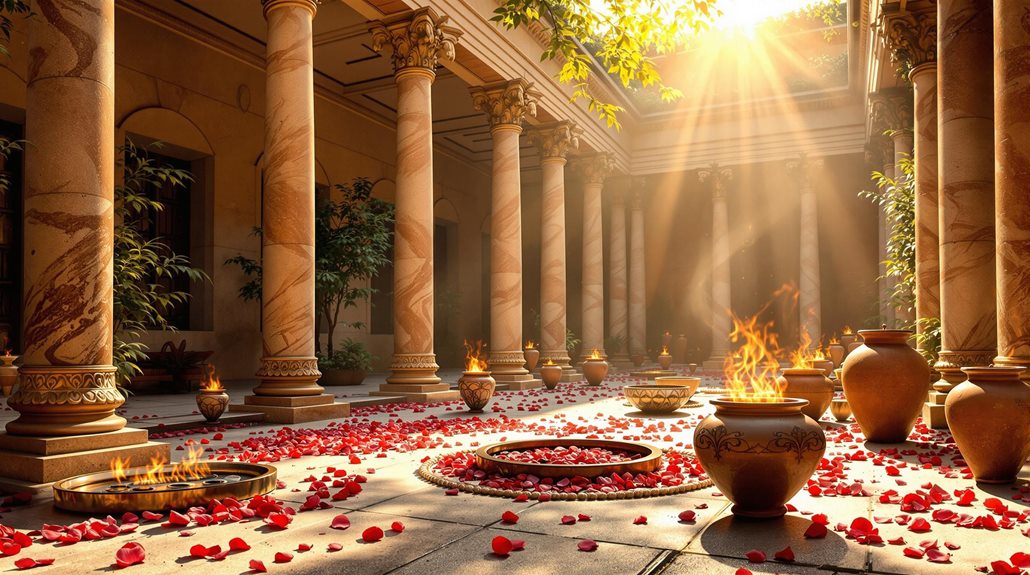
While Egyptian perfumery centered on divine worship, the Greeks and Romans altered fragrance into an art form that permeated daily life. You'll find that Greek perfume making was deeply rooted in mythology, with specific scents dedicated to their deities - rose water for Aphrodite and rich myrrh for Zeus. The Romans later expanded these practices, transforming perfumes into a symbol of sophistication and power.
The evolution of perfume making in the Classical world was marked by several innovations:
- Romans introduced glass containers for storing fragrances, replacing traditional clay vessels
- Greek perfumers specialized in enfleurage, extracting delicate scents from flowers
- Roman nobility developed complex scent combinations, documented by Pliny the Elder
- Public baths became centers of perfume use, where various fragrances marked different activities
When the Roman Empire fell, Europe's sophisticated perfume traditions declined. However, you'll find that the ancient Persians and other Middle Eastern cultures preserved and advanced these aromatic arts. They maintained the knowledge of perfume making through the medieval period, ensuring these precious techniques weren't lost to history.
Islamic Golden Age Innovations
Muslim scholars revolutionized perfumery during the Islamic Golden Age, altering ancient techniques into sophisticated scientific processes. You'll find that Muslim chemists like Al-Kindi and Avicenna developed pioneering steam distillation methods that reshaped how perfumes were made. Their innovations didn't just improve existing methods - they created entirely new ways to extract and preserve fragrances.
When you look at the Islamic world's contributions, you'll see that Iranian scientists were particularly influential in developing methods to extract essential oils from flowers and plants. These techniques would later mold Western perfumery's evolution. The Middle East became the epicenter of perfume production, introducing revolutionary perfume ingredients like musk, roses, and amber to the global market.
What's fascinating is that fragrance practices weren't just about luxury - they were deeply intertwined with religious duty in Islamic cultures. This spiritual connection drove continuous innovation in perfumery throughout the Islamic Golden Age. As a result, the Middle East established itself as the world's premier perfume hub long before European centers rose to prominence, creating a legacy that continues to influence modern perfumery.
Medieval European Aromatic Revolution
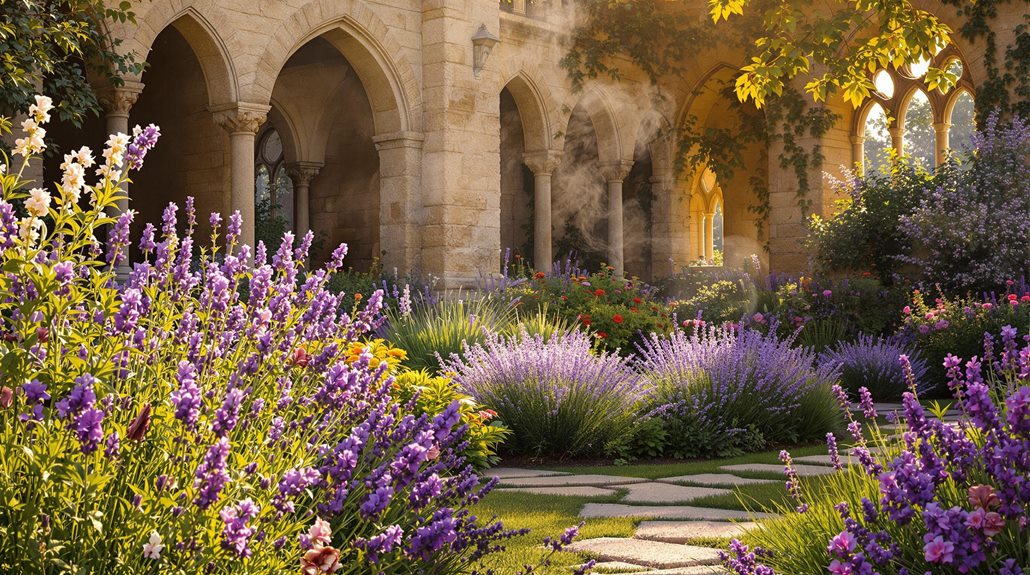
European perfumery underwent a dramatic alteration when Crusaders returned from the Middle East, bringing with them the sophisticated fragrance techniques they'd encountered. Returning crusaders ushered in a revolutionary period that would transform the art of perfumery across the continent. When Catherine de Medici moved to France, she brought along René le Florentin, whose specialized skills revolutionized the French perfume industry.
- You'd find scented gloves becoming a status symbol, particularly in Italian and French aristocratic circles.
- Nobles used complex, multi-note fragrances to distinguish themselves, with some perfumes containing dozens of ingredients.
- Perfume houses in Florence and Venice developed new extraction methods that you'll still see used today.
- European courts adopted perfume as a symbol of power, with rulers like Louis XIV leading the trend.
The metamorphosis wasn't just about luxury - it marked Europe's first systematic approach to perfume creation. From simple flower waters to sophisticated blends, you can trace back many modern fragrance techniques to this pivotal period. Venice and Florence emerged as early centers of excellence, laying the groundwork for what would become today's modern perfume industry.
Renaissance Perfume Masters
Expertise and innovation defined Renaissance perfumery through the work of legendary artisans who shaped the industry's future. You'll find that the Italian influence dominated this era, particularly through René le Florentin, Catherine de Medici's personal perfumer, who revolutionized French perfumery by introducing refined Italian techniques. He helped transform perfume from its religious origins into a symbol of luxury and sophistication.
The History of Perfume took a dramatic turn when Italian perfumer Guido Baldini created different scents that attracted Europe's nobility. Meanwhile, in Florence, the Medici family's patronage established the city as the first modern perfume capital, where craftsmen experimented with new ingredients and techniques. You'll see how perfume was used increasingly as a status symbol, especially in England, where Queen Elizabeth I's enthusiasm sparked a thriving industry. In Paris, Jean de Gournay's complex blends uplifted the art beyond mere scent-making. His work demonstrated how the word perfume had evolved to represent both artistic achievement and social prestige. Through these experts' contributions, Renaissance perfumery laid the foundation for modern fragrance creation.
Modern Fragrance Industry Developments
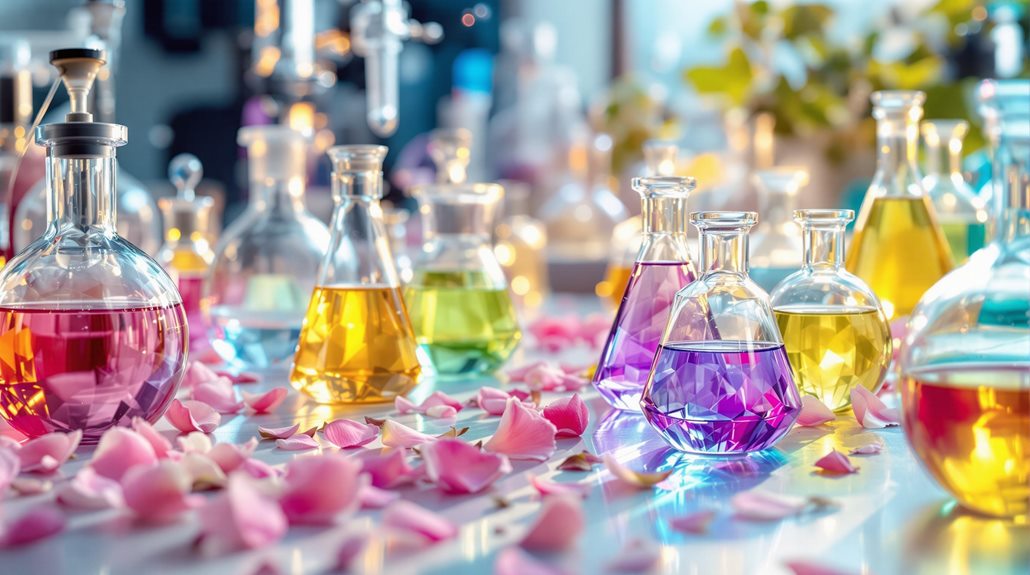
As fragrance production entered the 20th century, revolutionary changes metamorphosed the industry from an artisanal craft into a global powerhouse. The French company Coty pioneered modern perfumery by introducing impactful manufacturing techniques that would forever alter how perfume is made. The Industrial Revolution's advances in synthetic ingredients allowed perfume factories to produce fragrances at unparalleled scales, making luxury scents accessible to the mass market.
Key developments that shaped today's fragrance industry:
- The launch of Chanel No. 5 in 1921 established a transformative era of sophisticated perfumes that balanced natural ingredients with synthetic compounds
- Mass production techniques reshaped small perfume manufacturing operations into industrial-scale enterprises
- The rise of celebrity perfumes created a novel marketing paradigm, connecting fragrances with popular culture and fashion
- Sustainability concerns have pushed the industry to adopt ethical sourcing practices and eco-friendly production methods
Today's perfume industry continues to evolve, blending traditional craftsmanship with modern technology. You'll find that contemporary fragrance houses are increasingly focused on sustainable practices while maintaining the artistry that's defined perfumery for centuries.
Cultural Impact Through Time
Throughout human civilization, perfume has wielded extraordinary influence over social customs, religious practices, and cultural identity. The first perfume maker known to history was a woman named Tapputi, dating back to ancient Mesopotamia, who pioneered scent extraction techniques that influenced perfume-making around the world.
You'll find perfume's cultural significance deeply rooted in historical events, from ancient ceremonies to royal courts. When Queen Elizabeth of Hungary used perfume in the 14th century, she set trends that would influence European nobility for generations. Later, during Henry VIII's reign and Queen Elizabeth I's era, wearing perfume became more than just a personal choice—it augmented into a powerful status symbol, with even public spaces being scented to demonstrate wealth and sophistication.
The French aristocracy's aversion to bathing inadvertently elevated perfume's cultural significance, making France synonymous with fine fragrances. As you trace perfume's expedition through time, you'll notice how it evolved from a practical solution for masking odors to a symbol of luxury, eventually becoming an essential fashion accessory in modern culture.
Conclusion
You've investigated an aromatic trek spanning thousands of years, from Mesopotamian incense burners to today's designer fragrances. While you can't credit a single inventor, you've seen how each civilization has built upon previous knowledge, transforming perfume from sacred offerings to luxury items. What began as simple plant extracts has evolved into a sophisticated art form that continues to shape how you express yourself through scent.

